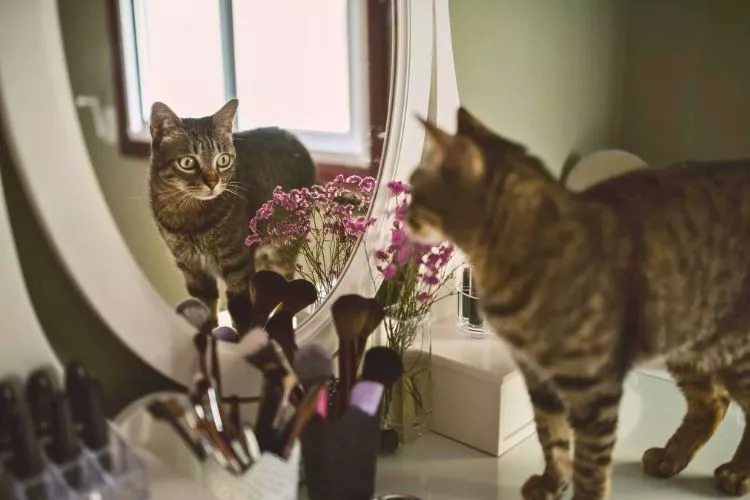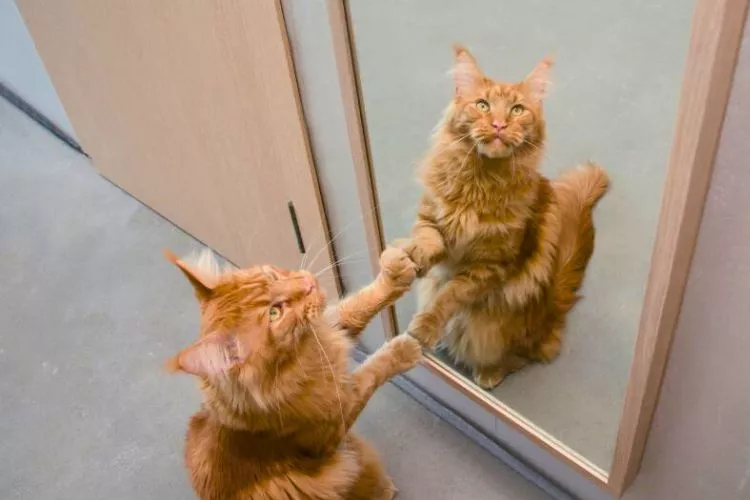Cats are known for their curious nature and intriguing behaviors. One behavior that can baffle cat owners is their tendency to scratch mirrors.
If you’ve noticed your cat scratching at mirrors, you may wonder why do cats scratch mirrors?

In this comprehensive guide, we will explore the reasons behind this behavior and provide solutions to address it effectively.
Understanding why cats scratch mirrors is the first step towards finding a resolution that satisfies both you and your feline companion.
🐾 Scratching as a Natural Behavior
Before delving into the specifics of why cats scratch mirrors, it’s essential to understand that scratching is a natural behavior for cats. Scratching serves essential functions, including:
- Marking Territory: Cats have scent glands located on their paws, and scratching leaves behind scents that signal to other cats that the area is claimed.
- Stretching and Exercise: Scratching helps cats stretch their muscles and maintain their agility. It’s a natural form of exercise that helps them stay limber and fit.
- Nail Maintenance: Regular scratching helps cats shed the outer sheath of their claws, keeping them healthy and sharp.
- Emotional and Stress Relief: Scratching can be a way for cats to release pent-up energy and alleviate stress. It allows them to engage in a natural behavior that provides physical and emotional stimulation.
Now that we understand scratching as a natural behavior, let’s explore why cats specifically target mirrors.
🐾 Why Do Cats Scratch Mirrors? Reasons

Visual Stimulation: Mirrors reflect light and movement, creating an intriguing visual experience for cats.
They may scratch at mirrors out of curiosity, trying to interact with their own reflection or investigate the movements they perceive.
Territory Marking: Cats have a strong instinct to mark their territory, and mirrors can be seen as a potential rival or intruder.
By scratching the mirror, they may be trying to assert their dominance and establish their presence in that space.
Sound and Texture: The sound and texture produced when a cat scratches a mirror can be different from other surfaces, such as furniture or scratching posts.
This novelty may attract their attention and encourage the behavior.
Stress or Anxiety: Cats may exhibit excessive scratching behavior when feeling stressed or anxious.
If there have been recent changes in their environment or routine, such as moving to a new house or the introduction of a new pet, this could trigger increased mirror scratching.
🐾 Solutions to Address Mirror Scratching

Understanding the motivations behind your cat’s mirror scratching behavior allows you to implement practical solutions to redirect their behavior in a positive way. Here are some effective strategies:
Provide Appropriate Scratching Surfaces: Cats need appropriate outlets for their scratching behavior. By providing sturdy scratching posts or boards covered with materials like sisal rope or carpet, you can redirect their attention away from the mirrors.
Place these scratching surfaces near the mirrors to offer an alternative that is equally accessible and desirable.
Deterrents and Distractions: Make the mirrors less enticing for your cat by applying deterrents to the mirror’s surface, such as double-sided tape, aluminum foil, or sticky paper. These textures can discourage scratching.
Additionally, offer alternative sources of entertainment and mental stimulation, such as interactive toys or puzzle feeders, to distract your cat from the mirrors.
Environmental Enrichment: Take steps to reduce your cat’s stress or anxiety by enriching their environment. Provide plenty of hiding spots like cozy cat beds or elevated perches, as these can provide a sense of security.
Additionally, engaging your cat in regular play sessions and providing vertical spaces for climbing and exploration can help them release pent-up energy and reduce undesirable behaviors.
Feline Pheromone Products: Consider using feline pheromone products, such as sprays or diffusers, which can help create a calm and reassuring environment for your cat.
These products mimic the natural pheromones that cats produce and can help alleviate stress-related behaviors, including excessive scratching.
Positive Reinforcement: Reward your cat with treats or praise when they engage in desired behaviors, such as using the scratching posts instead of the mirrors.
Positive reinforcement helps reinforce their understanding of what is acceptable and encourages them to repeat those behaviors.
Consult with a Veterinarian: If your cat’s mirror scratching behavior persists despite your efforts, it may be beneficial to consult with a veterinarian.
They can assess your cat’s overall health and behavior, rule out any underlying medical issues, and provide additional guidance specific to your cat’s situation.
You may also find Interesting: Why Does Cat Roll in the Litter Box? | Why Do Cats Flop Over?
Conclusion:
Scratching is a natural and necessary behavior for cats, but it can be frustrating when they focus their attention on mirrors. Understanding the motivations behind this behavior is key to finding effective solutions.
By providing appropriate scratching surfaces, reducing stress, offering distractions, and utilizing positive reinforcement, you can guide your cat towards more desirable scratching habits.
Remember, patience and consistency are essential in modifying your cat’s behavior. With time and the right approach, you can encourage your cat to engage in appropriate scratching behavior while preserving your mirrors.
